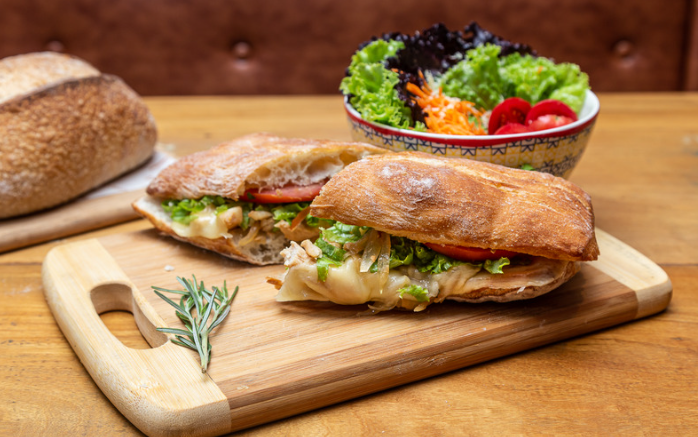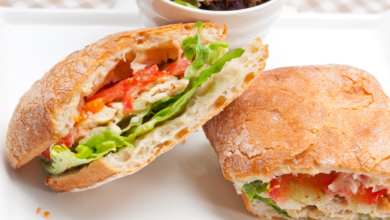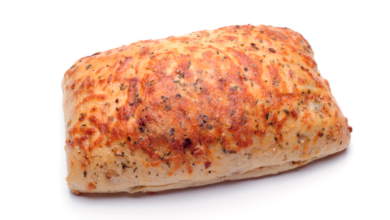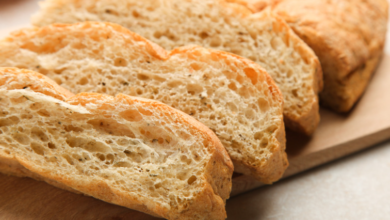Is Ciabatta Sourdough? It’s Not What You Think!

What To Know
- The starter is allowed to ferment over time, developing a tangy flavor and creating the characteristic sourness of sourdough bread.
- The dough is fermented for a shorter period compared to sourdough, resulting in a milder flavor and a more open crumb structure.
- No, a sourdough starter is essential for creating the tangy flavor and fermentation process of sourdough bread.
Ciabatta, a beloved Italian bread renowned for its open crumb and airy texture, has sparked a long-standing debate: is ciabatta sourdough? To shed light on this culinary conundrum, let’s delve into the depths of bread-making and explore the intricacies of these two distinct bread-making techniques.
Sourdough: A Time-Honored Tradition
Sourdough, a fermentation process that has been used for centuries, involves the natural creation of sourdough starter. This starter is a mixture of flour, water, and wild yeast and bacteria. The starter is allowed to ferment over time, developing a tangy flavor and creating the characteristic sourness of sourdough bread.
Ciabatta: A Modern Italian Classic
Ciabatta, on the other hand, is a relatively modern Italian bread that emerged in the 1980s. It is typically made with a combination of high-gluten flour, water, salt, and commercial yeast. The dough is fermented for a shorter period compared to sourdough, resulting in a milder flavor and a more open crumb structure.
Is Ciabatta Sourdough?
So, is ciabatta sourdough? The answer is both yes and no.
Traditional Ciabatta: No, traditional ciabatta is not made with sourdough. It is made with commercial yeast and does not undergo the same fermentation process as sourdough.
Sourdough Ciabatta: Yes, it is possible to make ciabatta bread using sourdough starter. This variation, known as sourdough ciabatta, combines the tangy flavor of sourdough with the open crumb structure of ciabatta.
Benefits of Sourdough Ciabatta
Sourdough ciabatta offers several benefits over traditional ciabatta:
- Improved Digestion: Sourdough fermentation breaks down the gluten in the flour, making it easier to digest.
- Enhanced Flavor: The natural fermentation process imparts a unique and tangy flavor to the bread.
- Longer Shelf Life: Sourdough bread typically has a longer shelf life than commercial yeast bread due to its acidic environment.
- Nutritional Value: Sourdough fermentation increases the bioavailability of certain nutrients, such as iron and B vitamins.
How to Make Sourdough Ciabatta
Making sourdough ciabatta at home requires patience and a sourdough starter. Here’s a simplified recipe:
Ingredients:
- 3 cups high-gluten flour
- 1 cup sourdough starter
- 1 cup warm water
- 2 teaspoons salt
Instructions:
1. Combine the flour, sourdough starter, and water in a large bowl.
2. Mix until a dough forms.
3. Add the salt and knead the dough for 5-7 minutes until it becomes smooth and elastic.
4. Place the dough in a lightly oiled bowl, cover it, and let it rise for 12-18 hours at room temperature.
5. Divide the dough into two loaves and shape them into ovals.
6. Place the loaves on a baking sheet lined with parchment paper and cover them with a damp towel.
7. Let the loaves rise for another 2-3 hours.
8. Preheat the oven to 450°F (230°C).
9. Score the loaves and bake for 25-30 minutes, or until golden brown.
Variations on Sourdough Ciabatta
The versatility of sourdough ciabatta allows for endless variations:
- Whole Wheat Sourdough Ciabatta: Substitute whole wheat flour for some or all of the high-gluten flour.
- Herb Sourdough Ciabatta: Add dried herbs, such as rosemary or thyme, to the dough.
- Cheese Sourdough Ciabatta: Sprinkle grated Parmesan or cheddar cheese on top of the loaves before baking.
Conclusion: The Versatility of Ciabatta
Whether you prefer traditional ciabatta or the tangy sourdough variation, this Italian bread offers a delicious and versatile staple. From crusty sandwiches to flavorful bruschetta, ciabatta is a culinary delight that can elevate any meal.
FAQ
Q: What is the difference between sourdough and commercial yeast?
A: Sourdough uses wild yeast and bacteria to ferment the dough, while commercial yeast is a cultivated yeast strain.
Q: How long does it take to make sourdough ciabatta?
A: The fermentation process for sourdough ciabatta typically takes 12-18 hours, plus additional time for shaping and rising.
Q: Can I make sourdough ciabatta without a sourdough starter?
A: No, a sourdough starter is essential for creating the tangy flavor and fermentation process of sourdough bread.





